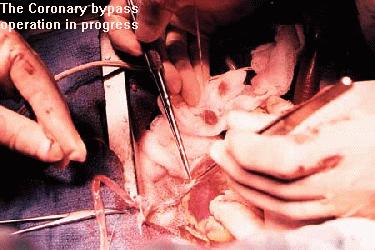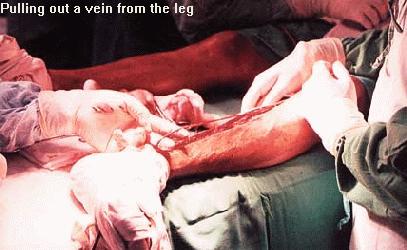

![]()
"I love you with all my heart" say young couples in love. But one is in for a shock when one sees the heart exposed for bypass surgery by surgeons trained for this arduous job. Purple in colour, one cannot quite define its shape. Moreover, it is covered unromantically with a lot of ugly yellow hued fat.
Dr. Y.K.M. Lahie, Consultant cardiac surgeon, only thirty nine years old was the chief surgeon for this operation. Youth not with standing, his skilled hands confidently operated on this, one of the most important organs of the body. Dr. I. Wijemanne Senior Registrar cardiology, ably assisted Dr. Lahie.
The bypass entails two operations. A team of doctors led by Dr. A. Rabel removed a long vein which looked like an elongated worm from the left leg of the patient. The vein would be cut to necessary size as the operation proceeded to bypass the arterial blocks.
 The
55-year-old patient weighing only 112 pounds had to have three bypasses. He had
been a longstanding high blood pressure case. "Today we do bypass
operations on patients as young as thirty six, if and when they suffer from
diabetes," said Dr. Lahie.
The
55-year-old patient weighing only 112 pounds had to have three bypasses. He had
been a longstanding high blood pressure case. "Today we do bypass
operations on patients as young as thirty six, if and when they suffer from
diabetes," said Dr. Lahie.
The consultant anesthetist Dr. Mrs. Hemantha Perera is a capable young woman who keeps an eye not only on the pulse but measures pressure in the various chambers of the heart and keeps tabs on the body temperature. This is invasive monitoring. She said she has a chat with the patient the previous day explaining the operation and taking note of the patient’s condition as she had to administer the general anesthesia.
She also keeps a wary eye on the large, white heart-lung machine, manipulated by those trained for that work.
It is weird, but true that in a heart operation of this type vital functions are taken over by the heart-lung machine. The patient’s blood circulation comes through tubes, gets purified and goes back into the body with the help of the heart-lung machine. A tube is inserted into the patient’s trachea to help as an artificial ventilator. To all intents and purposes the patient is at the mercy of his doctors and the machine.
Earlier an angiogram showed that there were three different blockages in the man’s arteries.
Dr. Wijemanne made an incision, used a diathermy probe to minimise blood loss and using a surgical electrical saw, yes a saw, cut the breast bone. This is a traumatic part of the operation. A retractor separates the breast bone and there inside is the human heart which has so been romanticized in novels and poetry. There is the aorta, the large artery. Heparin is given intravenous in the meantime, to prevent blood clotting which could otherwise endanger the patient’s life, said Dr. Hemantha Perera.
 The
patient is disinfected from the ankles upto the chin with iodine disinfectant,
Dr Lahie said. Led by Dr. R. Rabel the leg is cut and the needed vein is taken
out gently. For the most important coronary blood vessel that was blocked, an
artery from the back of the chest was taken to bypass it since it lasts longer
and has no ill effects on the patient by the removal of this artery.
The
patient is disinfected from the ankles upto the chin with iodine disinfectant,
Dr Lahie said. Led by Dr. R. Rabel the leg is cut and the needed vein is taken
out gently. For the most important coronary blood vessel that was blocked, an
artery from the back of the chest was taken to bypass it since it lasts longer
and has no ill effects on the patient by the removal of this artery.
An artery can be blocked by cholesterol or blood clotting. The chief surgeon then set about bypassing the blockages. Dr. K. Rabel explained seated after his work was over that a nick is made on the artery just after the blocking of that artery. The artery opens up and then the vein is grafted, there is no cutting or removal of the blockage. This is called in medical parlance ‘distal anastmosis’. One end of the vein is then grafted to the aorta. Only one point millimeter of the artery is bypassed. Meanwhile, the operation area is liberally sprayed with saline to clear any blood so that the surgeon can see clearly. A wire is used to lift the breast bone to make the bypass easy and wires about five or six are sewn together to close the breast bone.
The patient after the four hour operation will remain in the Intensive Care Unit, and in about ten days go back home to lead a normal life.
The surgical team is young since, explained Dr. Lahie. "You need a lot of staying power. Also a cardiac team must and has to be totally committed and dedicated. Nothing else counts. After all we are acutely aware, said Dr. Lahie "that the life of a human being is so totally in our hands with even his vital functions stopped."
But romantics need not be put off, still they can pledge their undying love with their hands to what is supposed to be where the heart is lodged!
The Sunday Times thanks The National Hospital for their coorperation.
In response to a long felt need to raise awareness of mental and psycho social disabilities, a National Mental Health Week has been declared in Sri Lanka from October 10 -16,1997. The National Mental Health Week will be launched on October 10, to coincide with the United Nations World Mental Health Day. The Declaration was signed by the Minister of Social Services with the approval of the President.
It is the first time that a National Mental Health Week has been declared in Sri Lanka. The Non Governmental Organization Sector working in the field has joined hands with the Social Services Ministry in conducting the nationwide activities for the National Mental Health Week. "Mental Health has been a neglected area. It is time to create awareness among the public, both young and old, about the importance of mental health", said Nimal Siripala de Silva, Minister of health and Indigenous Medicine speaking at a press conference on the National Mental Health Week.
Research conducted in Sri Lanka shows that 5%-10% of the adult population suffer from significant psychological disorders. An estimated 70,000 Sri Lankans suffer from Schizophrenia. The growing elderly population is increasingly vulnerable to dementia. Furthermore the high incidence of suicide, 49 per 100,000 of the population, which is estimated to be the highest in the world, is also largely related to mental stress and disorders. A Harvard report, commissioned by the United Nations, gives warning of an imminent epidemic of mental ill health in Sri Lanka. The consequences of the war situation in the north and east of the country and the exodus of migrant working women who leave their families behind, are found to be contributory factors for the escalation of mental disorders in the country.
Yet, mental health has so far been a neglected area receiving little priority of attention. There are just two mental hospitals, eight psychiatric wards in government hospitals. seven psychiatric clinics and four university psychiatric units to serve the needs of the entire country. Hospital facilities for in-patients are totally inadequate. For instance, at Angoda Mental Hospital, the premier Mental Hospital in Sri Lanka, there are 2,200 beds for an average of 3,500 patients. Many recovered patients linger on in the mental hospitals as they are rejected by their families, ostracized by their communities and have nowhere else to go. There are no follow-up programmes, rehabilitation centres or half-way houses for these patients.
The estimated number of 32 psychiatrists are mainly based in the vicinity of Colombo. There are four clinical psychologists, six psychiatric social workers and twenty trained psychiatric nursing staff in the country. "The mentally ill are the most disadvantaged sector of our population - neglected, rejected, despised and subject to inhuman treatment in the two mental hospitals that continue to cater most inadequately to the needs of mental patients since colonial times, states a presentation by the N.G.O. sector at the press conference on the National Mental Health Week held this week.
Four major aims have been identified for action. Initially, to mobilize public concern for the mentally ill persons who suffer unnecessarily from an illness which can be cured like any other illness. Secondly to raise mental health care from the low priority it now has, to a position of top priority. Thirdly to set up a community based system of mental health services and finally to develop a truly Sri Lankan approach to mental health.
In order to work towards these aims, the government together with the NGO Sector, have organized a series of community based activities at three levels, central, provincial and district. The National Health Week will be launched with an inaugural meeting under the patronage of the President. Public meetings, workshops, mass media programmes, school, cultural and religious activities as well as special programmes for the police, Armed Forces and Prisons will be held. NGOs with branches in the provinces are also planning special programmes particularly for displaced persons, refugees, bereaved families and children. The medical profession will also participate in special activities.
To prepare for an era of peace to follow the present strive and provide psychological aid to victims of war, is another target in view. The introduction of mental health education in the formal and non formal education systems, and strategies to care for the mentally disabled in the programme of devolution is also being thought about.
Return to the Plus contents page
![]()
| HOME PAGE | FRONT PAGE | EDITORIAL/OPINION | NEWS / COMMENT | BUSINESS
Please send your comments and suggestions on this web site to
info@suntimes.is.lk or to
webmaster@infolabs.is.lk